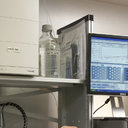Uric acid is associated with the prevalence but not disease progression of multiple system atrophy in Chinese population.
Atslēgvārdi
Abstrakts
Oxidative stress is involved in the pathogenesis of multiple system atrophy (MSA). Uric acid has an antioxidative effect. Our aim is to clarify the correlations between serum uric acid and MSA in Chinese population. A total of 234 patients with probable MSA and 240 age- and gender- matched healthy controls were included in the study. The serum uric acid levels of all the patients and controls were evaluated. The Unified MSA Rating Scale (UMSARS) was used to assess the severity and the mean rate of annualized changes of UMSARS to assess the progression of MSA. The mean age of MSA patients was 58.90 ± 9.00 years and the mean disease duration was 2.60 ± 1.75 years. The serum uric acid levels of MSA patients were significantly lower than that of controls in males (p = 0.0001). The occurrence of MSA was increased in the lowest uric acid quartiles compared with the highest uric acid quartiles (p = 0.005). In a gender-specific analysis, increased occurrence was found in the lowest quartiles and second quartiles compared with the highest quartiles in males (p = 0.001 and p = 0.0001 respectively), but not in females. No correlation was found between the mean rate of annualized changes and serum levels of uric acid, as well as other independent factors, such as age, BMI, gender, subtype (C-type or P-type) and disease duration at the initial visit in 107 followed-up patients. MSA patients have lower levels of serum uric acid than controls. High levels of serum uric acid may be associated with a lower prevalence of MSA in the Chinese population, especially in males. However, serum uric acid does not deteriorate or ameliorate the progression of MSA.



